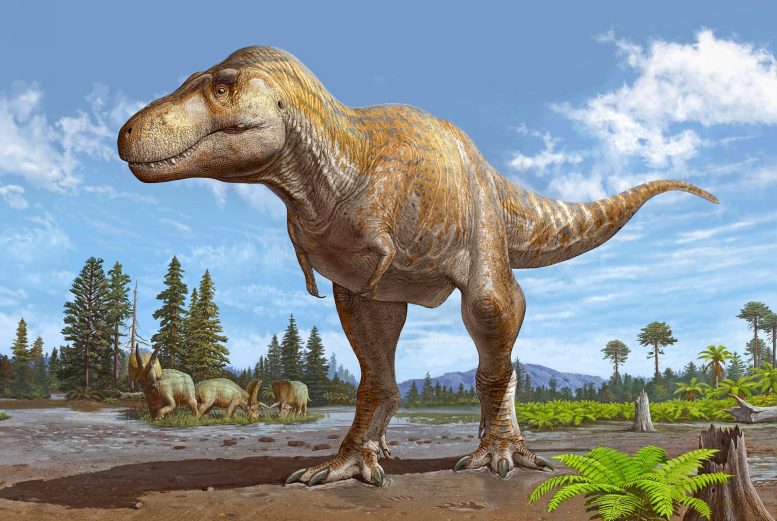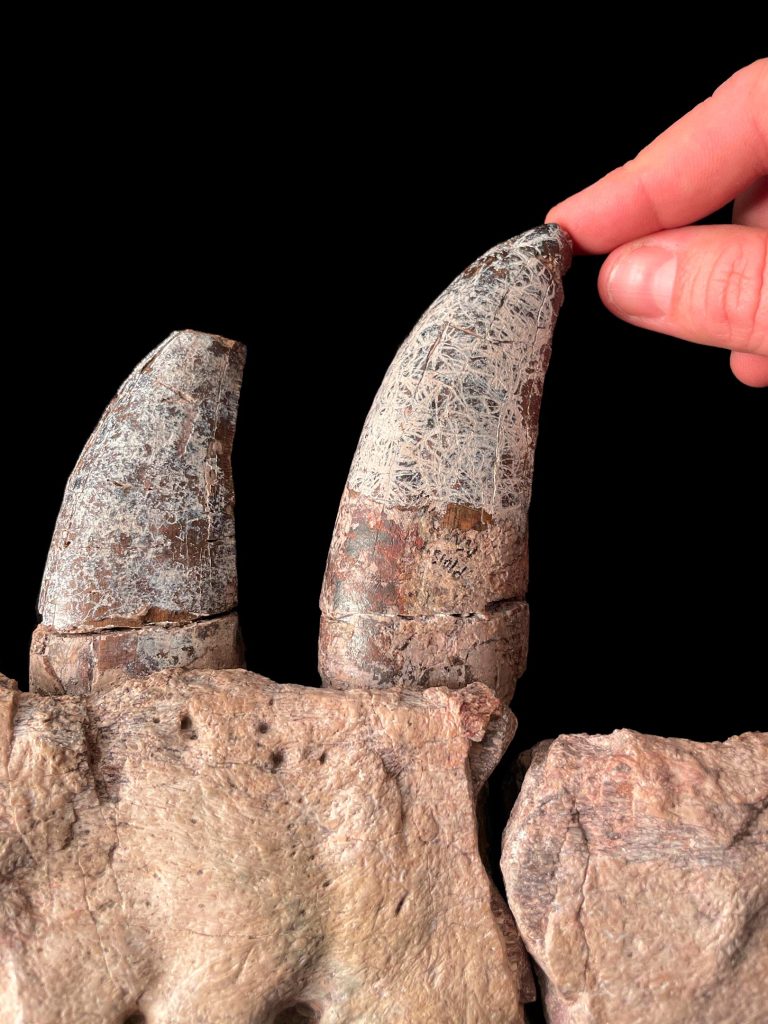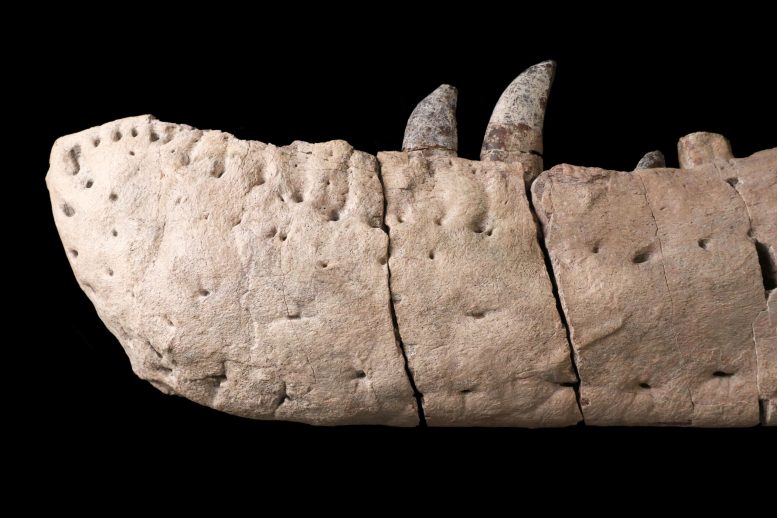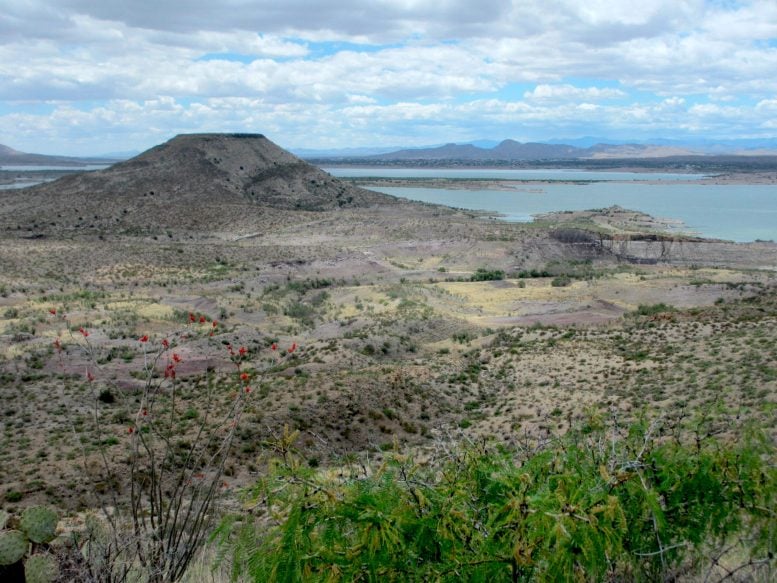
Reconstruction of Tyrannosaurus mcraeensis. Credit: Sergey Krasinski, edited
A study of fossils collected in New Mexico, D. in North America. Unearths key clues to Rex's origins.
A new study has been published Scientific reports The most famous dinosaur ever changed our understanding of how we walked the Earth – Dinosaur rex – came first to North America by introducing its earliest relative on the continent.
The study identifies a newly discovered subspecies of tyrannosaur known as Tyrannosaurus mcrensis. The newly discovered predator is older and more primitive than its better-known cousin, but just as large — roughly the size of a double-decker bus.
Discovery from New Mexico
The study, based on a partial skull collected years ago from western New Mexico and now on display at the New Mexico Museum of Natural History and Science (NMMNHS), shows that Tyrannosaurus was present in North America millions of years earlier than paleontologists previously thought.
Authors who contributed to the study included researchers from the University of Bath (UK), NMMNHS, University of Utah, George Washington University, Harrisburg University, Penn State Lehigh Valley and University of Alberta.
“New Mexicans have always known our state is special, and now we know New Mexico has been a special place for millions of years,” said Dr. Fiorillo, executive director of NMMNHS. “This study furthers the museum's mission through a science-based investigation of the life history of our planet.”

Teeth of Tyrannosaurus mcrensis. Credit: Nick Longrich
D. Rethinking Rex's Evolutionary Journey
Tyrannosaurus rex, the largest and most dangerous land predator of all time, suddenly appeared in North America 66 million years ago. But with no close relatives in North America, how it arrived on the continent remains a mystery.
When then-student Sebastian Dalman began re-examining a horned dinosaur from the same fauna, it forced a broader reexamination of dinosaurs from western New Mexico.
“I started working on this project in 2013 with co-author Steve Jasinski, and soon we began to suspect that we were doing something new,” said Dalman.
Finding subtle differences
A team of scientists from Bath (UK), USA and Canada came together to examine the animal, going bone by bone. In each case, they found subtle differences between the sample and dozens of others D. Rex Previously discovered skeletons.
Because D. Rex Most popular, New Mexico was able to show that the tyrant was new.
“The differences are subtle, but it's usually closely related species. “Evolution slowly builds mutations over millions of years, so that species differ in subtle ways over time,” said co-author Dr Nick Longrich of the Milner Center for Evolution at the University of Bath.

Jawbone of Tyrannosaurus mcrensis at the New Mexico Museum of Natural History and Science. Note the large scar on the back of the jaw, which the authors speculate may have been the result of a fight with another Tyrannosaurus. Credit: Nick Longrich
Tyrannosaurus mcrensis: a new species
New discoveries Tyrannosaurus mcrensis It was roughly the same size D. Rex, which is 40 feet (12 meters) long and 12 feet (3.6 meters) high. Like its popular cousin, Tyrannosaurus mcrensis ate meat. In advance of innovation D. RexThe paper notes that subtle differences in the jaw bones make it unlikely that it was a direct ancestor.
This raises the possibility that even more new tyrannosaur discoveries will be made.
“Once again, the scale and scientific importance of New Mexico's dinosaur fossils is evident – many new dinosaurs are yet to be discovered in the state's rocks and museum drawers!” Dr Spencer Lucas, Curator of Palaeontology at NMMNHS said.
Expanding our understanding of tyrannosaurs
The new discovery expands our understanding of tyrannosaurs in several ways. First, they suggest that apex predators lived in the southern United States at least 72 million years ago, long before the first fossils. D. Rex Found in the same area.
Tyrannosaurus probably originated in southern North America and later expanded to much of the western part of the continent.
New fossils collected on lands managed by the U.S. Bureau of Reclamation suggest that a larger, more heavily built and advanced species evolved in South America compared to the smaller and more primitive tyrants that lived in Montana and Canada. .

Kettle Top Bud in southeastern New Mexico. This fossilized jaw of Tyrannosaurus mcrayensis was found near the base of the bat. Credit: Dr. Spencer Lucas, NM Museum of Natural History & Science. Credit NM Department of Cultural Affairs
Conclusion: Unraveling Dinosaur Evolution
For reasons yet to be discovered, dinosaurs may have evolved to large sizes in the south, a body size pattern opposite to that found in modern mammals.
And then, at the very end Cretaceous Then, for unknown reasons, giant tyrannosaurs suddenly spread north, along with giant horned dinosaurs like Triceratops and Pterosaurus. The northward spread of giant-horned dinosaurs created a food source that could support giant tyrannies.
More than a century after Tyrannosaurus was first discovered, there's still a lot we don't know.
Note: Sebastian G. Dolman, Mark A. Lowen, R. Alexander Byrne, Steven E. Jasinski, D. Edward Malinczak, A Giant Tyrant from the Campanian-Maastrichtian of Southern North America and the Evolution of Tyranny Lucas, Anthony R. Fiorillo, Philip J. Curie and Nicholas R. Longrich, 11 January 2024, Scientific reports.
DOI: 10.1038/s41598-023-47011-0